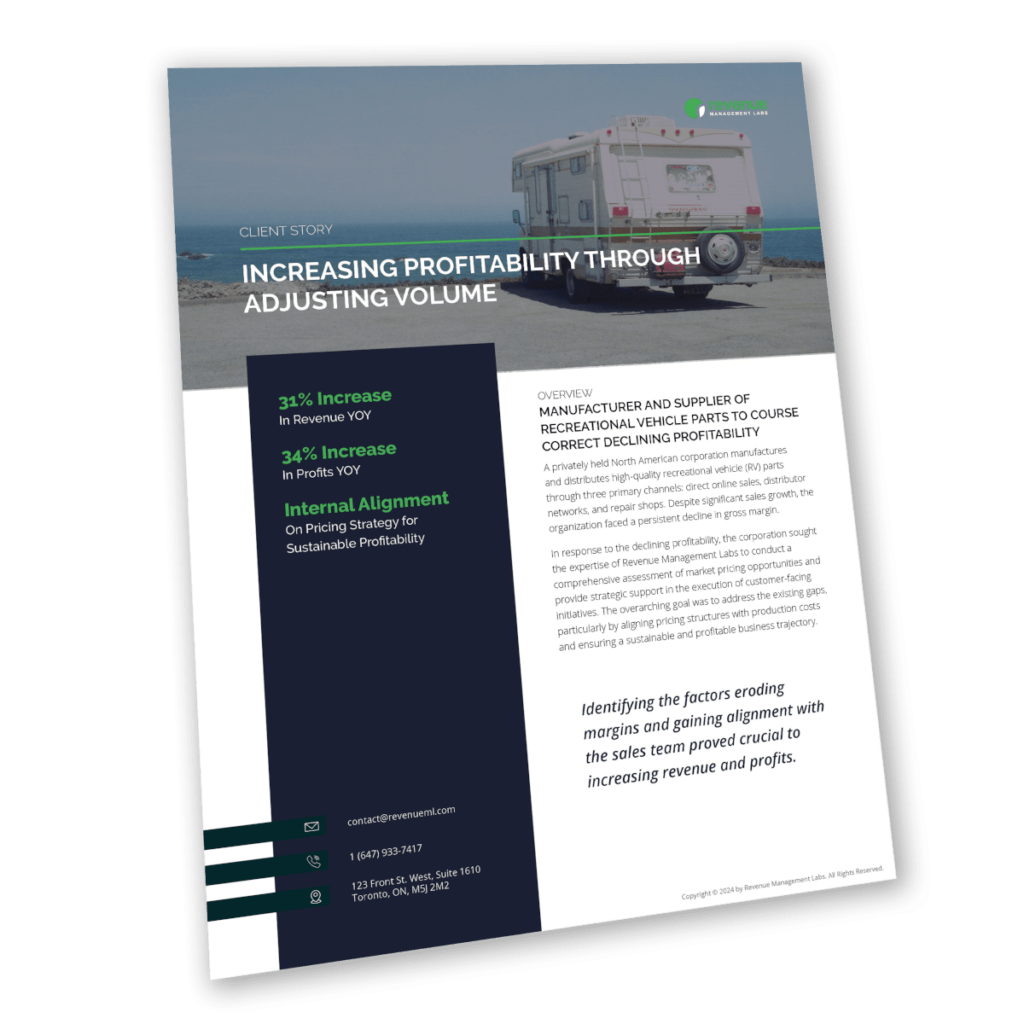Identifying the factors eroding margins and gaining alignment with the sales team proved crucial to increasing revenue and profits.
A privately held North American corporation manufactures and distributes high-quality recreational vehicle (RV) parts through three primary channels: direct online sales, distributor networks, and repair shops. Despite significant sales growth, the organization faced a persistent decline in gross margin.
In response to the declining profitability, the corporation sought the expertise of Revenue Management Labs to conduct a comprehensive assessment of market pricing opportunities and provide strategic support in the execution of customer-facing initiatives. The overarching goal was to address the existing gaps, particularly by aligning pricing structures with production costs and ensuring a sustainable and profitable business trajectory.
Several factors can contribute to a company experiencing declining gross margin despite sales growth. In the case of the RV parts manufacturer, the decline was narrowed to a combination of escalating discounts, stagnant pricing, product mix shift, and an increase in production costs. Other factors, we typically examine include market competition and overhead costs. Notably, the company also encountered challenges in implementing necessary price adjustments due to difficulties in effectively communicating and justifying these changes to internal stakeholders.
In Profits YOY

Review the advanced analytics behind our pricing strategy and the increase in revenue.
Revenue Management Labs identified two primary challenges faced by the organization:
a) Distributors (service end retailers or e-retailers) were selling at significantly lower prices than the suppliers’ own online prices, leading to price arbitrage and channel conflict.
b) The aggressive pricing from distributors fueled the channel’s growth but negatively impacted both revenue and profitability.
To address these issues, the pricing experts at Revenue Management Labs developed a new discount management strategy and identified opportunities to increase list prices on various SKUs. The list price and discount structure changes were integrated into a comprehensive pricing and promotion plan for the sales team. This plan, encompassing changes for sales reps, customers, and consumers, was crucial for transparency and success in the market. Revenue Management Labs also calculated the estimated impact on retail prices and customer margins, ensuring thorough review and discussion with the sales team prior to implementation.
The execution phase involved equipping the sales team with essential tools, including a sell deck for customers to understand the market-based pricing adjustments. The sales team received training on handling customer objections, sell-in strategies, and hands-on support for challenging customers. Revenue Management Labs further provided an executive dashboard to monitor implemented price actions, reporting forecasted vs. actual results monthly. This monitoring facilitated timely adjustments and ensured alignment with forecasted customer volumes.
Before narrowing our focus, Revenue Management Labs conducts comprehensive foundational analyses to fully understand the customer and market landscape. The declining gross margin with growing sales allowed us to focus our analysis on certain key areas, primarily price volume mix. Also called a sales bridge, the price volume mix analysis uncovers the dollar impact of price (rate or discount) and volume or mix (channel, customer, and item). Through price volume mix analysis, we discovered we discovered that nearly 70% of the volume gains were eroded by increased discounts, and unfavorable channel and product mix despite growing volume by $5.6 million year over year.
Revenue Management Labs used product segmentation and sentiment and cluster analyses as the basis for the collaborative value mapping sessions. Two groups emerged out of the value-mapping exercise, products that were value-advantaged and those that were value-disadvantaged.
The last step involved a restructuring of the discount system considering customer and product categories. Elasticity and value map outputs were utilized to identify opportunities for list price increases on various SKUs through financial modeling.
For a detailed review of the pricing methodology and data analysis,
download the full case study on price volume mix management for manufacturers and suppliers.
The impact of these pricing initiatives was assessed six months post-implementation, compared to the corresponding period in the previous year. Even after accounting for seasonality, new points of distribution, and product introductions, the company experienced remarkable growth, with a 31% increase in revenue and a substantial 34% boost in profits. This data underscores the profound success of the pricing strategies in driving tangible financial gains and establishing a robust foundation for sustained profitability.
We are here to help you achieve profitable revenue growth

We will cover the full results from our 2024 Executive Pricing Survey. See how you compare to your competitors both in past performance and for 2024 pricing strategy.